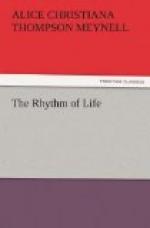THE FLOWER
There is a form of oppression that has not until now been confessed by those who suffer from it or who are participants, as mere witnesses, in its tyranny. It is the obsession of man by the flower. In the shape of the flower his own paltriness revisits him—his triviality, his sloth, his cheapness, his wholesale habitualness, his slatternly ostentation. These return to him and wreak upon him their dull revenges. What the tyranny really had grown to can be gauged nowhere so well as in country lodgings, where the most ordinary things of design and decoration have sifted down and gathered together, so that foolish ornament gains a cumulative force and achieves a conspicuous commonness. Stem and petal and leaf—the fluent forms that a man has not by heart but certainly by rote—are woven, printed, cast, and stamped wherever restlessness and insimplicity have feared to leave plain spaces. The most ugly of all imaginable rooms, which is probably the parlour of a farm-house arrayed for those whom Americans call summer-boarders, is beset with flowers. It blooms, a dry, woollen, papery, cast-iron garden. The floor flourishes with blossoms adust, poorly conventionalised into a kind of order; the table-cover is ablaze with a more realistic florescence; the wall-paper is set with bunches; the rigid machine-lace curtain is all of roses and lilies in its very construction, over the muslin blinds an impotent sprig is scattered. In the worsted rosettes of the bell-ropes, in the plaster picture-frames, in the painted tea-tray and on the cups, in the pediment of the sideboard, in the ornament that crowns the barometer, in the finials of sofa and arm-chair, in the finger-plates of the ‘grained’ door, is to be seen the ineffectual portrait or to be traced the stale inspiration of the flower. And what is this bossiness around the grate but some blunt, black-leaded garland? The recital is wearisome, but the retribution of the flower is precisely weariness. It is the persecution of man, the haunting of his trivial visions, and the oppression of his inconsiderable brain.




